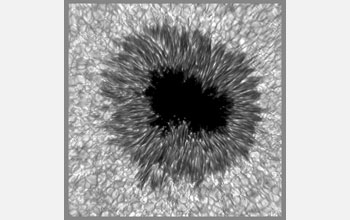Multimedia Gallery
High-resolution image of sunspot
High-resolution image of a sunspot, produced with a new camera attached to the Dunn Solar Telescope's adaptive optics system.
More about this image
An ultrasharp image of sunspot AR10805 (Sept. 28, 2005, 17:03:47 UTC) shows several objects of current scientific interest. G-band bright points, which indicate the presence of small-scale magnetic flux tubes, are seen near the sunspot and between several granules (columns of hot gas circulating upward). Normally, such features are beyond the grasp of ground-based solar telescopes because of blurring by Earth's turbulent atmosphere. High-order adaptive optics (AO) available at the National Science Foundation's Dunn Solar Telescope in Sunspot, N.M., compensate for much of that blurring, allowing the Dunn to observe up to 7 times sharper at its diffraction limit (theoretical best) of 0.14 arc-second resolution, rather than the 1.0 to 0.5 arc-second resolution normally allowed by Earth's atmosphere. The dark cores of penumbral fibrils and bright penumbral grains are seen as well in the sunspot penumbra (the fluted structures radiating outward from the spot). These features hold the key to understanding the magnetic structure of sunspots and can only be seen in ultra high-resolution images such as this one. Magnetism in solar activity is the "dark energy problem" being tackled in solar physics today.
This image was built from a series of 80 images, each 1/100th of a second long (10 ms), taken over a period of 3 seconds by a high-resolution Dalsa 4M30 CCD camera. The image was taken in G-band, a blue part of the spectrum (430.5 nm) where magnetic features stand out in high contrast. The finished image spans an angel of about 56 arc-seconds, equivalent to about 3.2 times the diameter of Earth, or 40,630 km (~25,190 miles), at the visible surface of the Sun. (Date of Image: unknown)
Credit: F. Woeger, Kiepenheuer-Institut fur Sonnenphysik in Freiburg, Germany (now with NSO); Chris Berst of NSO/AURA/NSF; Composite image by Dave Dooling, NSO/AURA/NSF.
Special Restrictions: The materials created, authored and/or prepared by the National Solar Observatory (NSO) are copyrighted in content, presentation and intellectual or creative origin. Before using this image, you must first read the Conditions of Use for NSO Images. Use of NSO/AURA images constitutes acceptance of these guidelines.
Images and other media in the National Science Foundation Multimedia Gallery are available for use in print and electronic material by NSF employees, members of the media, university staff, teachers and the general public. All media in the gallery are intended for personal, educational and nonprofit/non-commercial use only.
Images credited to the National Science Foundation, a federal agency, are in the public domain. The images were created by employees of the United States Government as part of their official duties or prepared by contractors as "works for hire" for NSF. You may freely use NSF-credited images and, at your discretion, credit NSF with a "Courtesy: National Science Foundation" notation.
Additional information about general usage can be found in Conditions.
Also Available:
Download the high-resolution JPG version of the image. (1 MB)
Use your mouse to right-click (Mac users may need to Ctrl-click) the link above and choose the option that will save the file or target to your computer.

